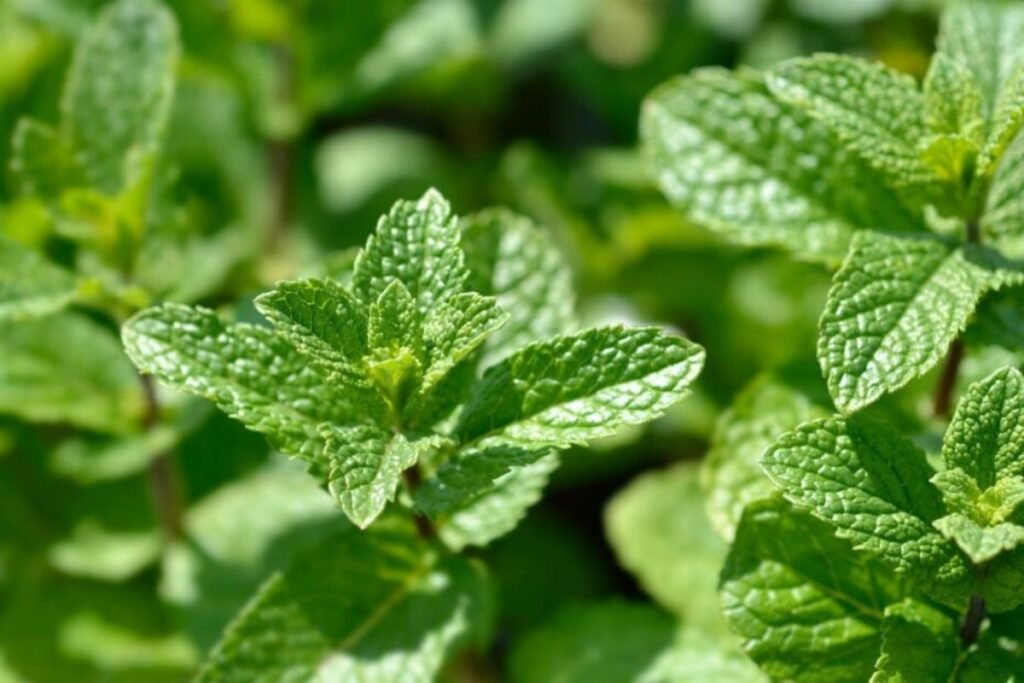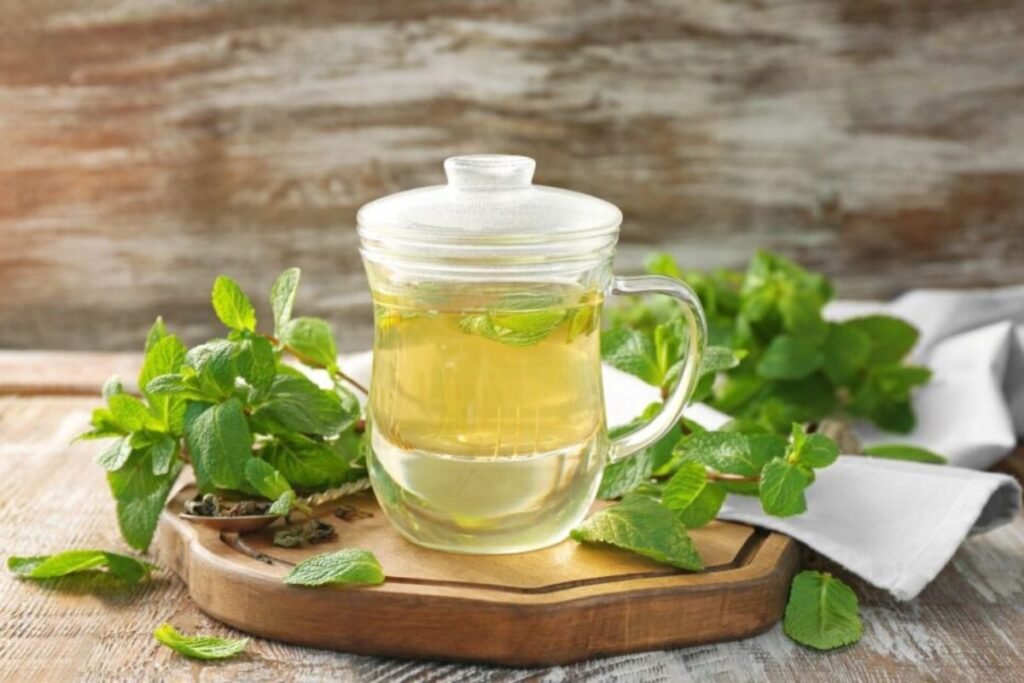What sets spearmint tea apart from the common mint? Spearmint tea is likely a familiar beverage for those who embrace growing and consuming various medicinal herbs. This tea boasts alluring, refreshing, and multifaceted qualities, making it a must-try for any mint lover or anyone dealing with particular ailments. Spearmint can resemble common mint but has a distinctive taste, unique visual characteristics, and added therapeutic benefits. Below, we will discuss spearmint tea benefits for health, advantages, preparation methods, and potential side effects.
What Plant is Used for Spearmint Tea?
The plant spearmint (Mentha spicata) is a mint with a curly appearance belonging to the Lamiaceae family. This plant family includes useful herbs such as thyme, sage, savory, marjoram, hyssop, oregano, rosemary, lavender, peppermint, and lemon balm.
Spearmint is a frequent guest in herb gardens and may resemble other close relatives, such as peppermint or different types and varieties of mint. Its distinguishing features include narrow, tapered 5–9 cm length leaves with serrated edges. The plant can reach 30–100 cm and may have hairy or smooth stems, square stems, and irregular pink or white flowers.
This cultivated plant is often grown in gardens or on windowsills. Popular varieties include Moroccan mint, Crispa, and Tashkent.

Spearmint Tea Flavor and Characteristics
Spearmint tea should not be too surprising for those who have tasted lemon balm, mint, or peppermint tea. This herb maintains a typical mild minty sweetness with a cooling sensation, though it is less intense. This can appeal to people who find peppermint or lemon balm tea too strong. Spearmint tea is described as sweet and subtly spicy, with hints of citrus, floral, and herbal notes, yet overall it is relatively mild. This flavor and aroma come from menthol, carvone, pinene, menthone, and limonene.
The tea’s color is generally green-brown, similar to other herbal infusions. Its fragrant minty aroma has refreshing qualities without revealing its specific origins, though gourmets may taste apricot-like notes.
Spearmint Tea Benefits: What Are They?
Spearmint tea offers many therapeutic and beneficial properties found in related herbal teas like peppermint, lemon balm, oregano, and thyme. Below are some of the health-enhancing characteristics associated with this tea.
Aids digestion
Spearmint can help alleviate digestive disorders, including nausea, gas, abdominal pain, and vomiting. Spearmint essential oil can also improve digestion when applied topically on the skin.
Enhances memory
Animal studies have shown that spearmint aids in learning and memory tasks. Similarly, people consuming 900 mg of spearmint extract daily improved their working memory by about 15%.
It helps regulate hormone levels in women
Research indicates spearmint can help manage hormonal imbalances, increasing female hormones (like estradiol) and reducing testosterone. This is beneficial for women dealing with irregular menstrual cycles and unwanted hair growth. Studies on rats have shown that spearmint oil increases fertile egg counts due to hormone regulation. So, it may be potential for women with polycystic ovary syndrome, occurring spearmint tea benefits PCOS.
Acts as an antibacterial
There’s a reason why the essential oil of spearmint improves toothpaste and chewing gum. This essential oil not only adds freshness but also combats bacteria. Research suggests spearmint oil is mild to moderately effective against common pathogens E. coli, Gram-positive bacteria Staphylococcus epidermidis, and Candida glabrata.
Antioxidant and anti-inflammatory properties
It is often mentioned that antioxidant-rich drinks or foods have a beneficial effect against harmful reactive oxygen species and the inflammation they cause. Like other antioxidant-rich foods, spearmint helps combat harmful free radicals and inflammation, which can prevent conditions such as cancer, type 2 diabetes, and cardiovascular diseases. Among other things, antiproliferative studies of spearmint on 3 cancer cell lines have shown that this plant (specifically 1,8-cineole and limonene compounds) can help fight cancer by inhibiting its growth.

Lowers blood sugar
Although the results of studies in humans are still pending, animal studies have shown that spearmint may help regulate blood sugar levels. Research with diabetic rats experiencing lowered blood sugar after consuming spearmint supplements showed these results.
Reduces stress and improves sleep
It’s no secret that a soothing mint tea is needed to promote good sleep. Spearmint has similar relaxing properties to other mint family plants, calming the nervous system and reducing stress. The same or similar substances in these plants react with GABA receptors, which are responsible for stress relief.
Relieves arthritis pain
Arthritis patients who regularly drink spearmint tea can forget about joint pain. Regularly drinking spearmint tea can help ease arthritis pain. In fact, extracts and oils of lamb mint also relieve other types of pain, increase joint flexibility, and reduce stiffness. This pain relief effect is mainly due to the menthol content in spearmint.
Lowers blood pressure
It is worth considering people suffering from hypertension, whether you should regularly consume spearmint tea. The carvone compound in spearmint has a similar effect to calcium channel blockers, often used to treat high blood pressure. This is the same principle used in high blood pressure medications. However, the research is still in its early stages, but the animal tests are very promising.
Composition of Spearmint Tea
Spearmint tea has almost no calories (only about 2 kcal per cup or 44 kcal per 100 g of fresh spearmint leaves). It is free of fats, caffeine, and cholesterol but is rich in antioxidants. Along with aromatic compounds like menthol, spearmint contains vitamin C, flavones, flavonoids, iron, dihydrocarvone, cineole, folate, sodium, and potassium.
The researchers also isolated 44 unique compounds from the oil, most of which (about 67%) were oxygenated monoterpenes. Of course, you will absorb a higher amount of these substances by directly chewing the garden mint leaves or using them as a condiment in dishes, but the tea alternative is also effective.
Harvesting Spearmint
Spearmint can be harvested from your garden or found in herb shops. You should collect the plant before it blooms because it preserves its medicinal properties. Choose the morning after the dew dries, when the essential oils in plants are most concentrated.
Lay the peeled leaves and stems in a single layer in a well-ventilated, dry, dark room. You can also dry these mints by tying them in bundles and hanging them upside down. You can also choose the oven for faster drying – keep the temperature at 50 °C and after 20 minutes you will have dried leaves.

Preparing Spearmint Tea
You need just a few simple ingredients to make a basic herbal tea, but feel all spearmint tea benefits:
- 1 tablespoon of dried spearmint or several fresh leaves
- 250 ml of boiling water
Preparation:
- Rinse the fresh spearmint under cold water. Place the leaves or dried spearmint into a teapot or cup.
- Pour boiling water over the spearmint and let it steep for 5–10 minutes, depending on the desired strength.
- Strain the tea through a sieve or remove the leaves.
- Add a teaspoon of honey or agave syrup for a sweeter taste.
Lavender and Spearmint Tea with Orange and Ginger
We suggest you try this unique lavender tea recipe for those who want to add additional flavors and experience enhanced spearmint tea benefits.
Ingredients:
- 1 tbsp dried spearmint leaves or 2–3 fresh sprigs of spearmint
- 2 orange slices
- 1 teaspoon dried lavender flowers
- 1 teaspoon finely grated fresh ginger
- 250 ml boiling water
- 1 teaspoon honey or agave syrup (optional).
- 1–2 cardamom pods (optional).
Preparation:
- Place the spearmint, lavender flowers, grated ginger, cardamom pods (if using), and orange slices in a cup.
- Pour boiling water over the top and cover with a saucer. Allow to infuse for 8–10 minutes
- Strain the tea through a sieve into a cup
- Add a teaspoon of honey or agave syrup if you prefer a sweeter taste.

Potential Side Effects of Spearmint Tea
While spearmint is a delicious herb with numerous health benefits, some individuals should exercise caution:
- People with acid reflux (heartburn) should avoid spearmint tea as it relaxes the lower esophageal sphincter, which may worsen symptoms.
- Men may experience reduced testosterone levels, which could lower libido and potentially impact erectile function.
- Some individuals may experience allergic reactions.
- Other side effects are indicated when the use of spearmint is taken in unreasonably large quantities. In this case, the kidneys and liver suffer. High levels of spearmint tea are also not recommended for pregnant women as it can damage the uterus.
Sources:
- https://www.masterclass.com/articles/spearmint-vs-peppermint-explained
- https://www.webmd.com/diet/spearmint-tea-health-benefits
- https://www.healthline.com/nutrition/spearmint
Research:
- https://pubmed.ncbi.nlm.nih.gov/16868824
- https://pubmed.ncbi.nlm.nih.gov/17310494
- https://pubmed.ncbi.nlm.nih.gov/29399556
- https://pubmed.ncbi.nlm.nih.gov/29970065
- https://pubmed.ncbi.nlm.nih.gov/29769013
- https://pubmed.ncbi.nlm.nih.gov/25058311
- https://pubmed.ncbi.nlm.nih.gov/28107842
- https://pubmed.ncbi.nlm.nih.gov/23103297
Associative photos © Canva.

